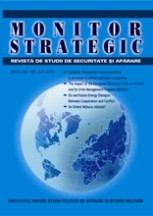Menținerea păcii și securității la nivel internațional Limitele de acțiune ale Organizației Națiunilor Unite
Maintaining international peace and security. The
limits of United Nations’ action
Author(s): Mirel Țariuc, Simona Țeighiu JurjSubject(s): International relations/trade, Security and defense, Geopolitics, Peace and Conflict Studies
Published by: Editura Militară
Keywords: UN Security Council; peacekeeping operations; observation missions; Romania's participation in UN operations; post-conflict reconstruction;
Summary/Abstract: In order to maintain international peace and security (the first UN objective according to its Charter), the UN decides the establishment and deployment of peace-missions in areas affected by serious problems. These missions which are based on the agreement by the target-countries are restricted regarding the right to use of force, excepting for the peace-keepers’s self-defence. There are several types of missions to be deployed by the UN, from the origin until today, even if the peace-keeping missions were not mentioned as such in the UN Charter. The responsibility for peace-keeping missions belongs to the Security Council, meaning that it is dependent on the favorable vote by the five countries holding the permanent membership status. In time, some of the UN missions has been successful, while others hasn’t. Success involves peace achievement and greatly depends on the goodwill of the forces involved in conflicts before the peace agreement or truce. Failure is not generated by the operation itself, but one can debate whether results depends on different legal and political circumstances. The studies dedicated to this topic reflect the patterns of action for the UN missions, but also mention the chances for successful outcomes.
Journal: Monitor Strategic
- Issue Year: 2021
- Issue No: 3-4
- Page Range: 62-70
- Page Count: 9
- Language: Romanian

